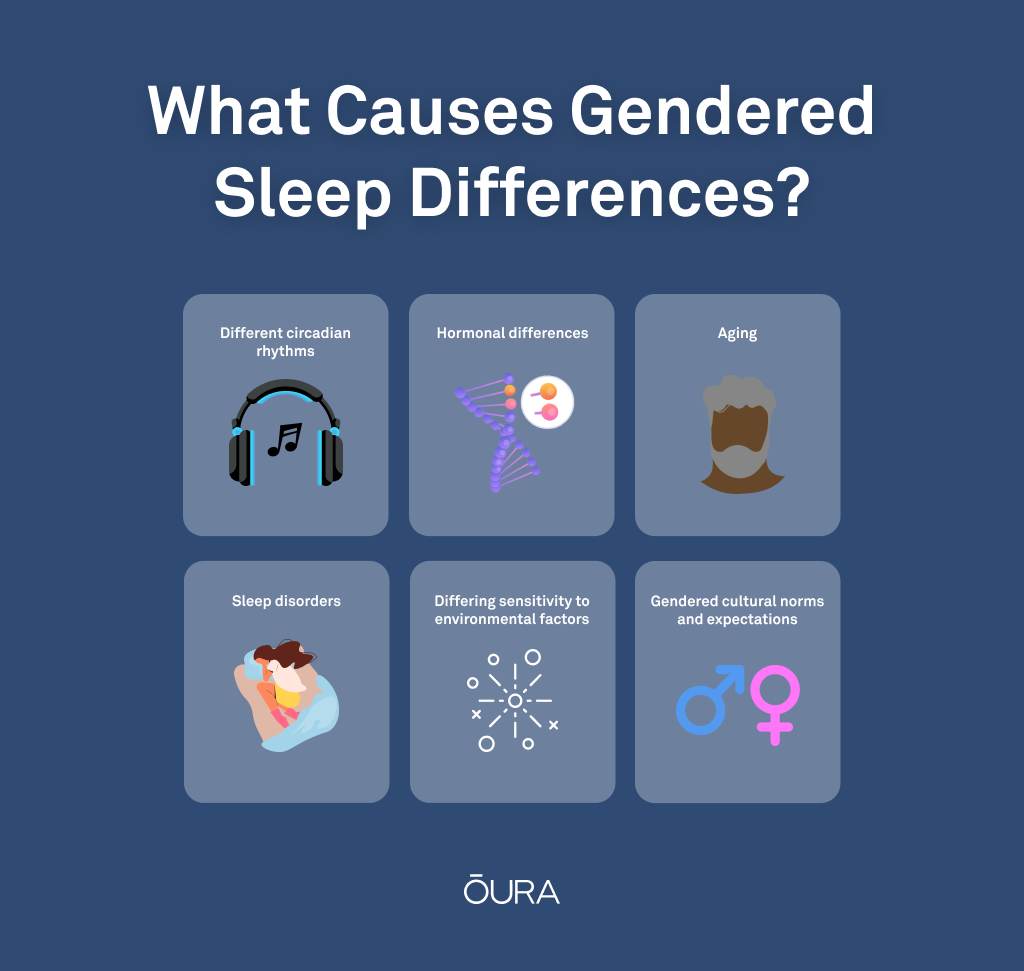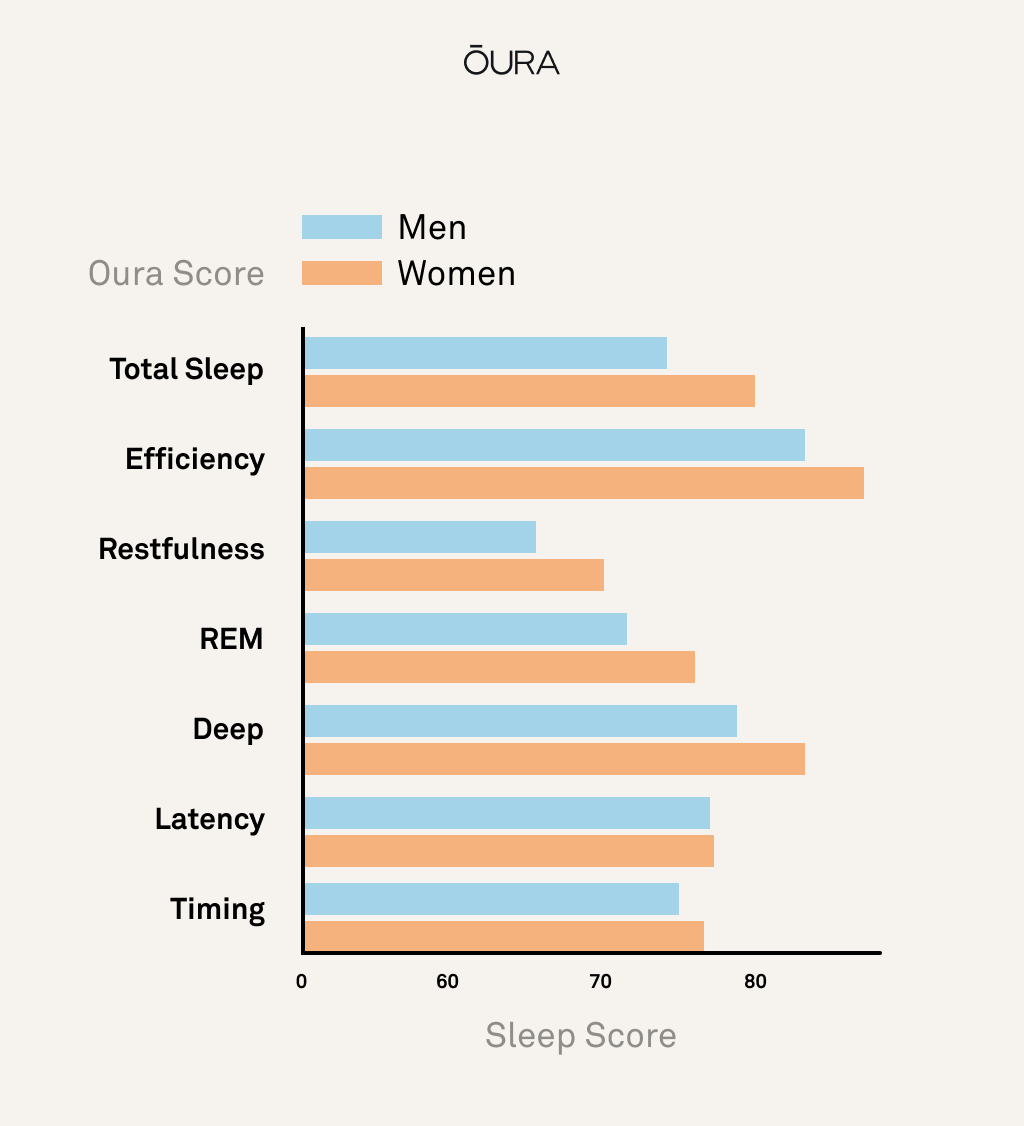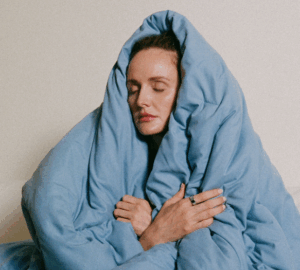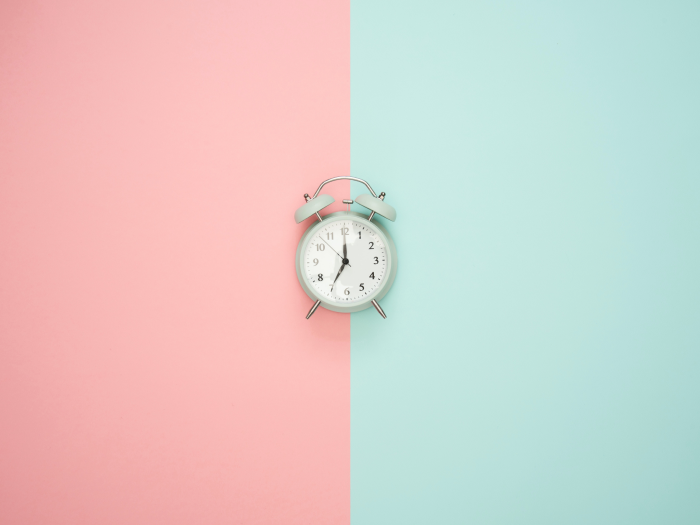You’ve heard the saying, “men are from Mars, women are from Venus.” As it turns out, the biological differences between men and women also extend to male and female sleeping patterns.
According to one study from Loughborough University’s Sleep Research Center in England, women need 20 minutes more sleep than men. One possible reason the researchers put forth? Women tend to use more of their brains during the day as they stay busy multitasking and doing a lot of things at once (really!).
And, Oura member data from 2020 backs this up: We found that women scored higher than men in almost all sleep markers, including total sleep time, more REM sleep, and more deep sleep.
Read on to discover the science behind the differences in male and female sleeping patterns, plus what the anonymized Oura data revealed about the differences in our members as well.
The Biology of Gender Differences in Sleep
Understanding the differences between male and female sleeping patterns is one thing, but getting familiar with the biological differences that cause these variations can help support better sleep.
According to Raphael Vallat, PhD, neuroscientist and senior machine learning data scientist at Oura, growing evidence indicates that, on average, women in the United States get more total sleep each day than men when counting nightly sleep and daytime naps. In one large study, the average time difference depended on age and ranged from five to 28 minutes.
However, women tend to experience more sleep fragmentation and lower quality sleep. Some researchers believe that many women have increased sleep quantity as an attempt to compensate for reduced sleep quality. A recent paper analyzing 11.14 million wearable nights from 69,000 adults confirmed that there are gendered sleep disparities that persist throughout our lifetimes.
In general, men sleep less than women across their lifespan — however, nighttime awakenings are more prevalent for women, especially during the child-rearing years of early to middle adulthood.
To understand these differences, let’s take a closer look at some of the biological and social factors that make men and women different sleepers.
6 Causes of Gender Differences in Sleep
1. Different Sleep Cycles
Studies indicate that differences in circadian rhythms may be behind the different sleep habits men and women tend to adopt. Although most people’s circadian rhythms are not exactly 24 hours long, women’s internal clocks are typically a few minutes shorter.
Because of this shorter sleep-wake cycle, women’s bodies can start sending out sleep signals up to two hours earlier than men’s. This means that women tend to wake up earlier and be alert early in the day, while men are typically more alert at night and find it easier to sleep later in the morning.
Whether you’re a morning person, a night owl, or somewhere in between, knowing your chronotype can help you manage your habits to make sure you get enough sleep. Oura members can now discover their chronotype, consult the Body Clock feature, and receive Bedtime Guidance based on their chronotype.
READ MORE: Oura Data Shows How Members’ Chronotypes Vary by Age, Gender, and Location
2. Hormonal Differences
Hormones play a significant role in the sleep differences between men and women, and we know that hormonal fluctuations throughout the menstrual cycle cause sleep disruptions for women.
For example, studies show that a drop in estrogen and rising progesterone levels during the luteal (premenstrual) phase can affect women’s sleep quality. Additionally, hormonal changes during pregnancy and menopause can cause insomnia and hot flashes that may disturb sleep.
RELATED: What Causes Period Nightmares?
But hormonal changes don’t just affect women — low levels of testosterone in men have been linked to sleep problems such as insomnia, lower sleep efficiency, and increased wakefulness during the night.
While there’s less research into how high testosterone levels affect men’s sleep, one study found that overweight and obese men with high testosterone are more prone to shallow sleep. Another study found that men with high testosterone levels were more susceptible to daytime sleepiness and impaired mental performance after a poor night’s sleep.
And those pesky hormones don’t stop there — they even cause differences in how men and women dream. For instance, rising progesterone and lower levels of melatonin during the luteal phase lead to sleep disturbances that reduce the amount of time women spend in REM sleep, which is when most dreaming occurs. Therefore, women tend to spend less time in REM sleep and dream less during that phase than men.
RELATED: What Are the 4 Stages of Sleep?
3. Aging
Research suggests that aging affects the way men and women sleep in different ways. For example, one study of adults aged 20 to 40 found that as men age, they spend less time in slow-wave deep sleep and REM sleep, while no changes in female sleep patterns were observed at this age. This is consistent with Oura’s findings.
For women, the effects of hormonal changes on sleep as they age remain unclear. While some research suggests that menopause negatively impacts sleep quality, one study found that middle-aged women experienced an increase in sleep duration and fewer nighttime awakenings over a period of 12 years as they went through menopause.
RELATED: The Surprising Link Between Menopause and Sleep Apnea

4. Sleep Disorders
Although obstructive sleep apnea is more prevalent in men, research from Loughborough University’s Sleep Research Center in England suggests that sleep disorders disproportionately affect women. Those researchers found that 18 percent of women experience poor sleep compared to just eight percent of men. Other studies have shown that women are 40 percent more likely to have insomnia than men.
READ MORE: Sleep Apnea, Defined — and How to Treat It
These disruptions are usually the result of the biological phases of a woman’s life, such as menstruation, pregnancy, and menopause, and the hormonal shifts that accompany them.
The Loughborough scientists found that sleep deprivation affects women’s mood and mental health much more than men’s, leading to greater psychological distress and feelings of “hostility, depression, and anger.” This could explain why women are twice as likely to be diagnosed with anxiety and depression — two conditions strongly associated with insomnia.
5. Differing Sensitivity to Environmental Factors
One study found that environmental factors affect men’s and women’s sleep quality differently — for example, men are more susceptible to changes in air temperature and CO2 levels, while women are more likely to be disturbed by noise.
RELATED: How Sleeping Background Noise Can Impact Your Sleep Quality
6. Gendered Cultural Norms and Expectations
Women are often expected to be primary caregivers for their children, and working moms are twice as likely to get up at night to breastfeed or care for their babies as working fathers. Moreover, 28 percent of women who are the sole breadwinners for their families said they get up at night to take care of their children, compared to just four percent of male breadwinners.
READ MORE: Practice Mindful Parenting with These Guided Meditations for Mothers
What Oura Data Says About Male and Female Sleeping Patterns
Oura compared the Sleep Scores of 6,000 men and 6,000 women from 1,847,057 nights of sleep in 2020.
It’s important to note that during this time, pandemic lockdowns were being imposed and lifted, with varying levels of restriction, at different times in different countries. We plan to repeat this analysis in mid-2023 to understand if the results are consistent outside of the global pandemic and with our updated sleep staging algorithm.
The findings show that women scored higher than men in almost all sleep markers, including:
- Total Sleep
- Sleep Efficiency
- Restfulness
- REM Sleep
- Deep Sleep
- Timing
The only sleep marker that was the same for both genders was Sleep Latency — indicating little to no difference in how long men and women take to fall asleep.

This data also showed that, compared to men, women spent significantly more time in REM and deep sleep and less time in light sleep. This may be because women go to bed earlier than men, but men and women tend to wake up around the same time.
Understanding Your Body for a Good Night’s Sleep
Understanding how male and female bodies sleep differently can help you take steps to get more quality sleep. But for personalized data and recommendations based on your biology, head to the Oura App.
There, you’ll find your Sleep Score, which tells you how well you slept last night based on markers such as sleep duration and efficiency. Use this data to make changes to your bedtime routine and see how they impact your sleep.
RELATED: Got a Theory? Test It Out
About the Oura Expert
Raphael Vallat, PhD, is a senior machine learning data scientist at Oura. He previously worked as a sleep researcher in the Center for Human Sleep Science at University of California Berkeley (Prof. Matt Walker‘s lab). He has published extensively on the topic of sleep and human health, and his work has been featured in several major news media and podcasts. In his free time, you can find him enjoying precious moments with his amazing wife and daughter, playing music, or hiking with friends.










